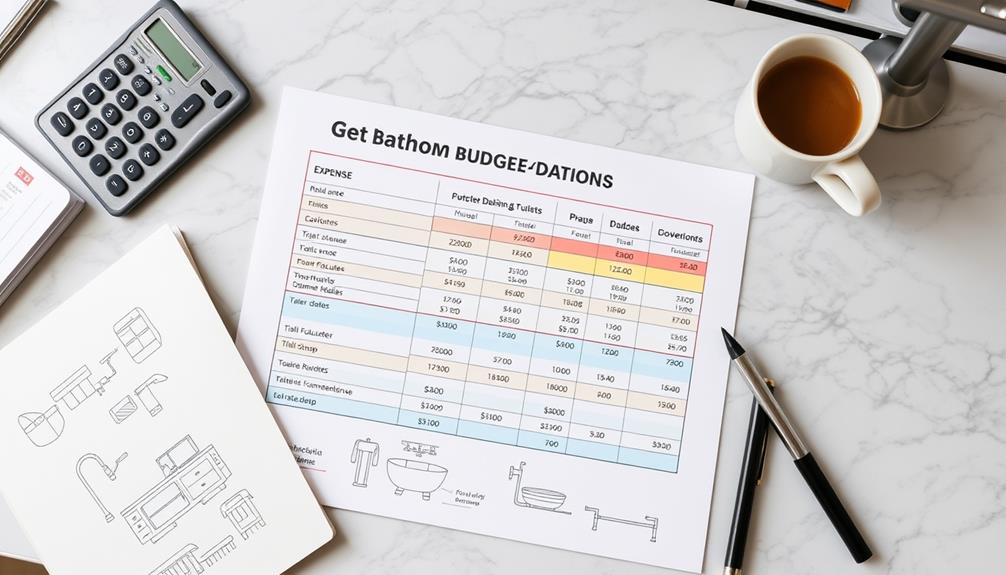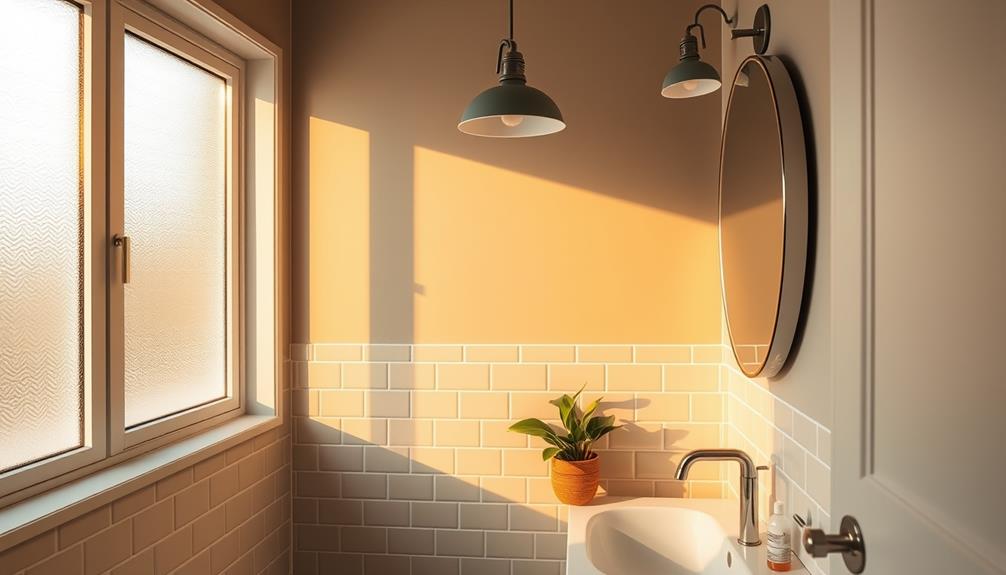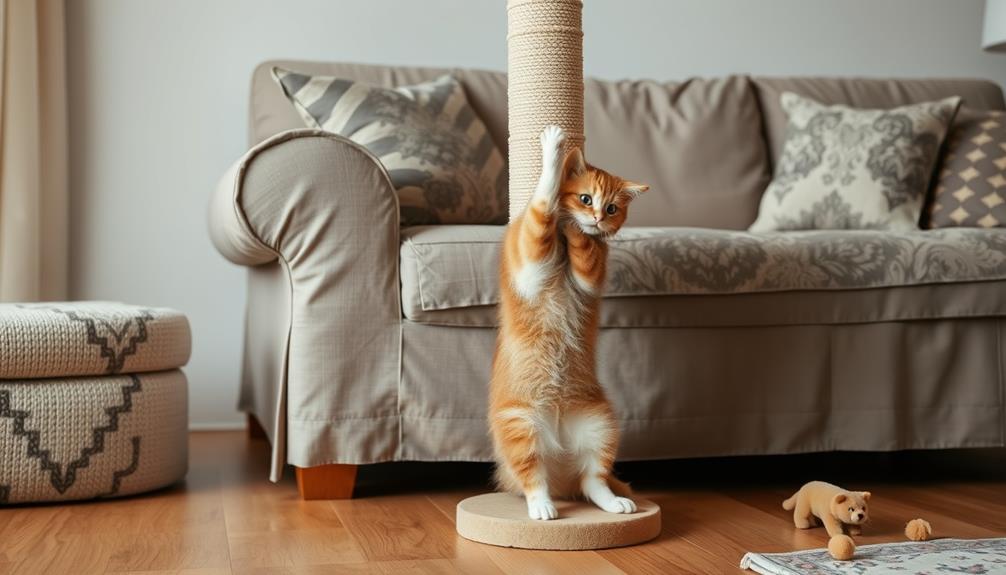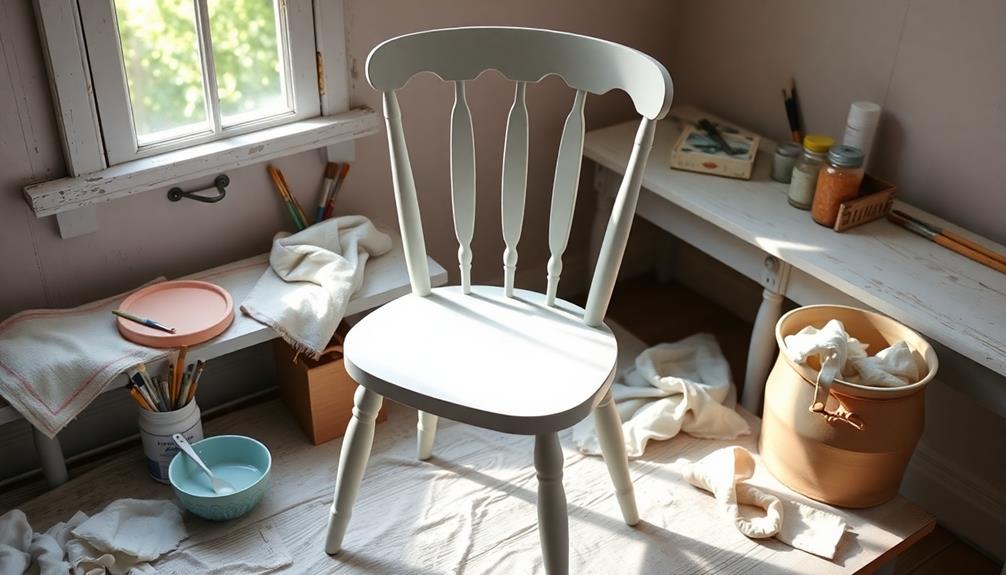To plan for a bathroom renovation, first get a handle on typical costs, ranging from $2,000 to $18,000. Clearly define the scope of your project and set achievable goals. Take into account both material and labor costs, with labor typically consuming 60-70% of your budget. Make sure to allocate a contingency fund of 20-30% for unforeseen expenses like unexpected plumbing issues. Evaluate the upgrades you desire, comparing costs to your budget. Lastly, consider balancing DIY tasks and hiring professionals to maximize cost savings. There is much more to delve into to ensure a successful bathroom makeover!
Key Takeaways
- Determine the total estimated costs by considering your project scope, which can range from $2,000 to $18,000 for a bathroom remodel.
- Allocate 20-30% of your budget for unexpected expenses, such as hidden plumbing or structural issues that may arise.
- Research and compare material costs to avoid financial surprises, ensuring you account for quality and desired upgrades.
- Factor in labor costs, which typically make up 60-70% of the total budget, and consider hiring skilled trades for complex tasks.
- Establish clear project goals and communicate effectively with contractors to keep your remodel on track and within budget.
Understanding the Remodel Costs
When you’re planning a bathroom remodel, understanding the remodel costs is essential to staying within your budget. Typical bathroom remodel costs range from $2,000 to $18,000, with an average cost of about $5,500 for a standard project. It’s important to keep in mind that the cost of a bathroom remodel can vary greatly depending on the size of the space, the quality of materials, and the extent of the renovation. However, there are affordable bathroom renovation options that can help keep costs down, such as opting for budget-friendly materials, doing some of the labor yourself, or prioritizing specific areas for updates. By carefully considering these options, you can achieve the bathroom remodel you desire while staying within your budget.
If you're considering a mid-range bathroom remodel, expect to spend around $27,164, which can yield a return on investment (ROI) of approximately 58.9%.
To effectively manage these costs, it's important to create a personal budget that tracks your income and expenses, allowing for a clearer picture of your financial situation. Additionally, consider setting specific savings goals to help you prioritize your remodeling project over time.
Several factors influence remodeling costs, including bathroom size, type, and the complexity of the design. Larger and more intricate bathrooms usually require more funds.
Material costs can also notably impact your budget, as high-quality fixtures and finishes often lead to increased expenses.
Don't forget to account for labor costs, which can vary based on the complexity of your project and local rates.
It's wise to budget for unexpected costs by adding an additional 20-30% to your total estimated project cost. This cushion will help you navigate unforeseen issues, ensuring your home improvement project remains on track financially.
Setting Realistic Project Goals
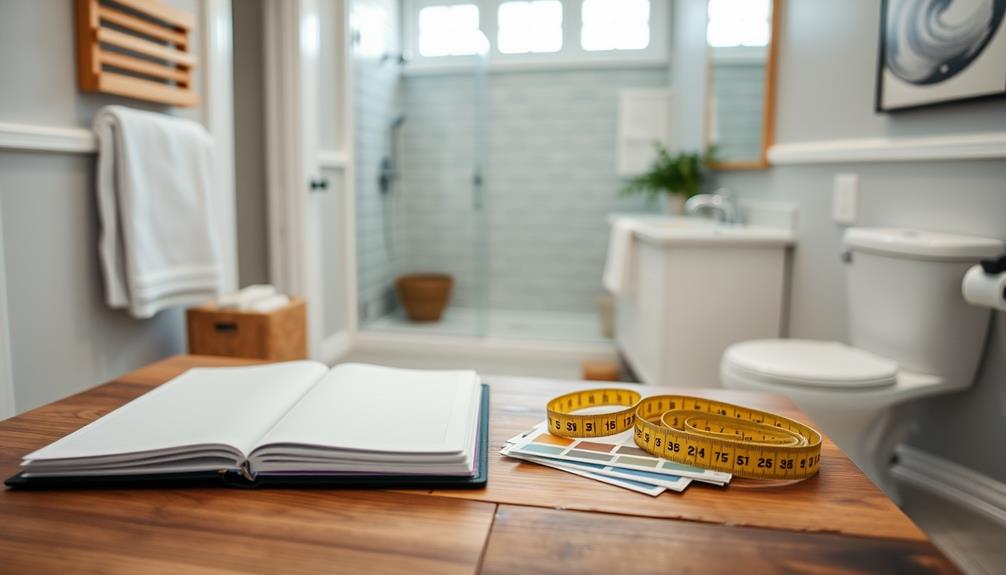
When setting realistic project goals for your bathroom remodel, start by defining the project scope.
Decide if you want a complete gut renovation or just a few upgrades, as this choice will shape your budget.
Clear goals will also help you communicate effectively with contractors and keep your project on track.
Define Project Scope
Defining the project scope is essential for setting realistic goals in your bathroom remodel, as it lays the foundation for your budget. Start by deciding whether your bathroom remodeling projects will involve a complete gut renovation or just simple fixture replacements. This decision will guide your budget estimates and prevent you from falling for costly, Pinterest-inspired designs that just don't fit your financial plan.
Consider incorporating elements like DIY Fire Pit Ideas for an outdoor ambiance that can complement indoor designs, making your overall home aesthetic more cohesive.
Next, identify the specific upgrades you want, like changing layouts or fixtures, since these choices greatly impact overall costs and project complexity. Early planning allows for effective budget allocation, ensuring you account for all necessary components, from materials to labor.
Don't forget about clear communication with your contractors. By clearly defining the project scope, you can prevent misunderstandings that may lead to budget overruns or delays during the remodeling process.
Setting these realistic goals upfront will help you stay focused and on track, making your bathroom remodel smoother and more manageable. Ultimately, by taking these steps, you'll set yourself up for a successful project that aligns with both your vision and your budget.
Assess Desired Upgrades
Setting realistic project goals starts with evaluating the desired upgrades for your bathroom remodel. Begin by identifying the specific upgrades you want, such as new fixtures, cabinetry, or layout changes. These decisions greatly influence your overall remodeling costs.
Consider the average costs for different upgrades; for example, prefabricated vanities can range from $200 to $1,000, while custom options might cost between $500 and $4,000. Additionally, you may want to think about how effective transforming your garden can be when planning for sustainable materials or eco-friendly options in your bathroom.
Next, decide if you're aiming for a complete remodel with structural changes or a simpler renovation focusing on cosmetic updates. Remember, complete remodels typically incur higher costs.
To set realistic goals, compare your desired upgrades with the average remodeling costs, which can range from $9,000 to $48,000 depending on your project's scope and complexity.
Lastly, avoid unrealistic expectations by considering budget constraints and available space. This thoughtful assessment will help you make informed decisions about your desired upgrades, ensuring your bathroom remodel aligns with your vision and financial limitations.
Analyzing Labor Expenses
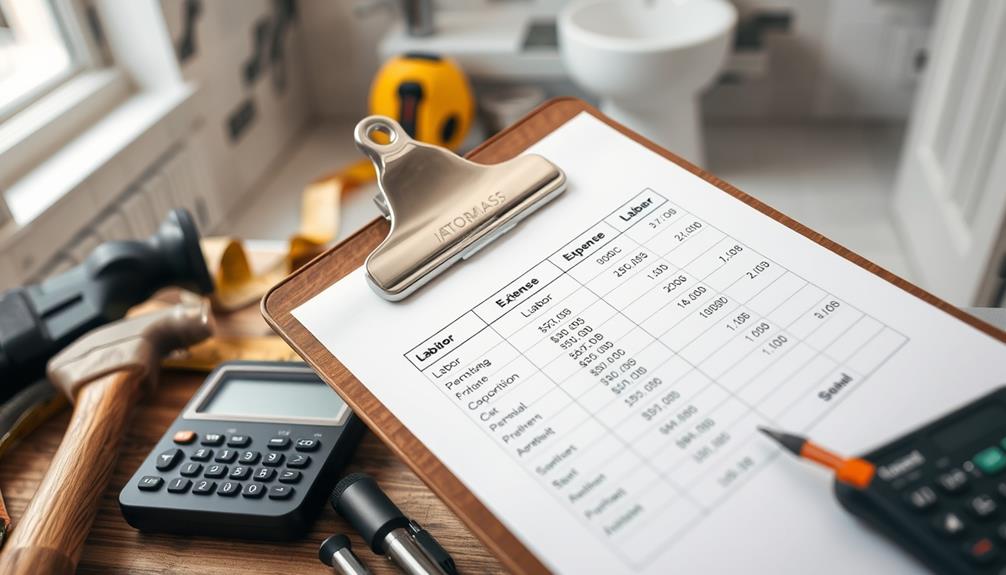
When you're budgeting for your bathroom remodel, understanding labor costs is essential since they often make up 60% to 70% of your total expenses.
This is similar to how appliance maintenance plans can greatly impact overall costs, as preventive maintenance can extend appliance lifespan greatly.
You'll need to weigh the importance of hiring skilled trades against the potential savings of tackling some tasks yourself.
Let's break down those labor expenses and see how they fit into your overall budget.
Labor Cost Breakdown
Many homeowners underestimate the impact of labor costs when budgeting for a bathroom remodel. In fact, labor costs can account for 60% to 70% of your total budget. If you hire a contractor, their fees will greatly influence overall expenses, especially when it comes to plumbing labor and electrical work.
It's crucial to take into account that unexpected issues may arise during the remodel, which could further increase labor costs, making it wise to set aside a contingency fund. Additionally, cold medications overview can provide insight into managing any discomfort you might experience during a stressful remodeling process.
Plumbing labor typically ranges from $45 to $65 per hour, and if your project is complex, plumbing costs can climb to several thousand dollars. Electrical work is another expensive aspect, with rates between $65 and $85 per hour. Depending on the scope of the tasks, total expenses for electrical installations can easily exceed $1,500.
Don't overlook tile installation, either. This labor can be one of the priciest components of your remodel, averaging around $6,600 for intricate designs and patterns.
When you add these figures together, you'll see how quickly labor costs can escalate, impacting your final price. It's crucial to plan your budget carefully, ensuring you account for these important labor expenses to avoid surprises down the line.
Skilled Trades Importance
Recognizing the significance of skilled trades in a bathroom remodel can greatly impact your budget and overall project success. Labor costs typically account for 60% to 70% of your total renovation budget, making it vital to take into account the value of hiring professionals.
Additionally, understanding the financial considerations for elderly care can provide insights into budgeting for home improvements. Here are a few key points to keep in mind:
- Specialized Skills: Skilled tradespeople, such as licensed plumbers and electricians, are essential for tasks that require expertise, guaranteeing safety and compliance with building codes.
- Cost Factors: Electricians generally charge between $65 and $85 per hour, while plumbers range from $45 to $65 per hour. Understanding these rates helps shape your remodeling budget.
- Labor Expense Breakdown: For an average remodel, plumbing labor alone can cost around $4,915. Knowing this allows for better financial planning.
- Quality Assurance: Engaging skilled trades can expedite the process and guarantee quality work, potentially preventing costly mistakes that might arise from DIY efforts.
DIY vs. Professional Choices
Deciding between DIY and professional services can greatly impact your bathroom remodel budget. Labor costs typically account for 60% to 70% of your total budget, so it's essential to weigh your options carefully.
While DIY projects can help you save money, especially on manageable tasks like painting or installing fixtures, you'll need to evaluate the complexity of plumbing and electrical work. Hiring a licensed plumber or electrician is often necessary due to safety regulations, which can add to your project costs.
Balancing these choices reflects the principles of design thinking, encouraging you to empathize with your needs and constraints while envisioning innovative solutions.
If you decide to hire a general contractor, keep in mind that their fees will contribute substantially to your overall labor expenses. Electricians generally charge between $65-$85 per hour, while plumbers charge $45-$65 per hour.
By acting as your own contractor and tackling simpler tasks, you can maintain control over your budget and potentially reduce your expenses. However, be cautious—taking on too much may extend your project timeline or lead to costly mistakes.
Ultimately, assess your skills and the scope of your home renovation project to find the right balance between DIY efforts and professional help.
Preparing for Unexpected Costs
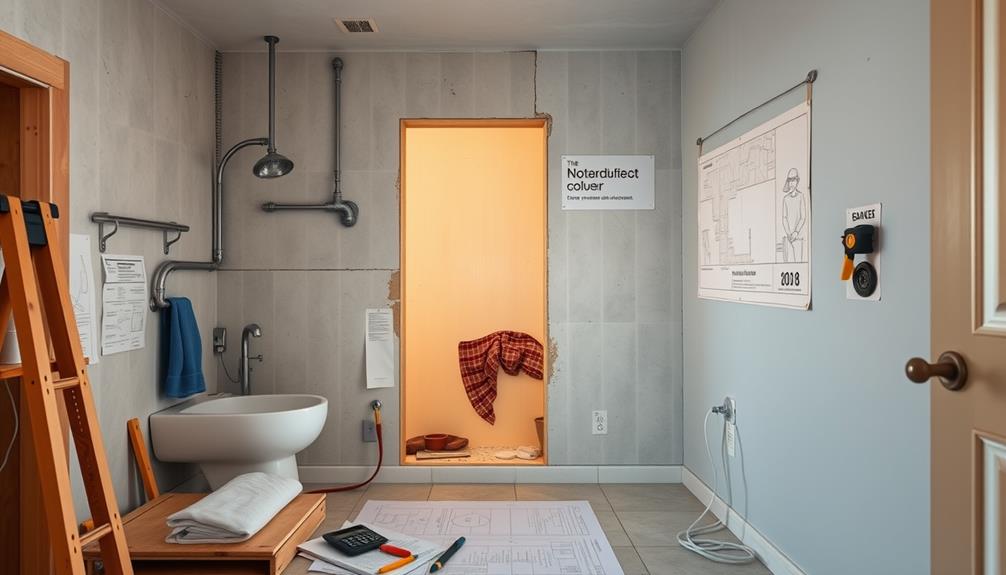
When budgeting for a bathroom remodel, it's crucial to set aside a portion of your funds for unexpected costs that can pop up during the renovation process.
It's wise to allocate at least 20% of your total budget to cover these potential expenses. Bathrooms often have intricate plumbing and electrical systems that can lead to hidden issues, like leaks or outdated wiring, which may not surface until the remodel begins.
Plus, moisture problems can arise, greatly increasing your costs if not accounted for initially. Understanding the potential for unexpected issues can help you avoid emotional dysregulation related to financial stress, similar to how individuals with BPD experience intense emotional responses.
To help you prepare for these financial surprises, consider these key points:
- Planning Cushion: Aim for a cushion of at least 30% for extensive remodels where complications are more likely.
- Hidden Plumbing Issues: Be ready for potential plumbing repairs that can spike your expenses unexpectedly.
- Electrical Updates: Outdated wiring might need attention, adding to your budget.
- Mold and Moisture: Addressing mold or moisture problems can lead to more costs, so factor these in from the start.
Material Cost Considerations
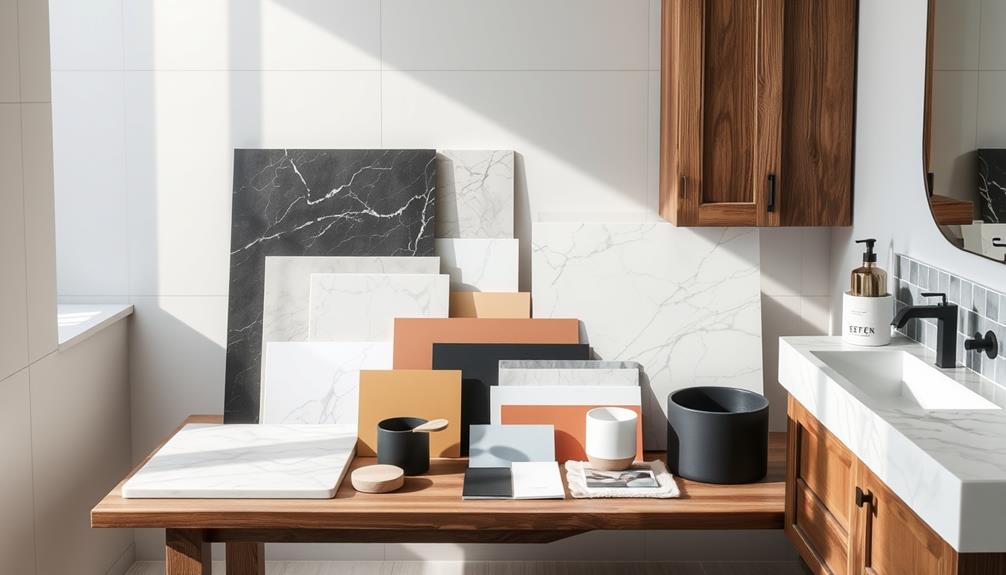
Unexpected costs can quickly add up during a bathroom remodel, so it's crucial to have a clear understanding of the material expenses involved. When you're budgeting, start by reflecting on the significant bathroom remodel costs associated with tile materials, which can average around $1,942.26. This expense alone can heavily influence your overall material budget.
Additionally, you might want to think about incorporating elements like essential oils for respiratory health to create a soothing atmosphere in your newly remodeled space.
Don't overlook the larger items, like a 60-inch double vanity, which can set you back approximately $2,160. Shower fixtures and accessories, including faucets and shower heads, typically amount to about $1,314.75. These costs require careful material cost evaluations to avoid financial surprises later on.
Additionally, if you're aiming to enhance the room's aesthetic, Venetian mirrors can add decorative value but will cost around $619.98.
DIY vs. Professional Help
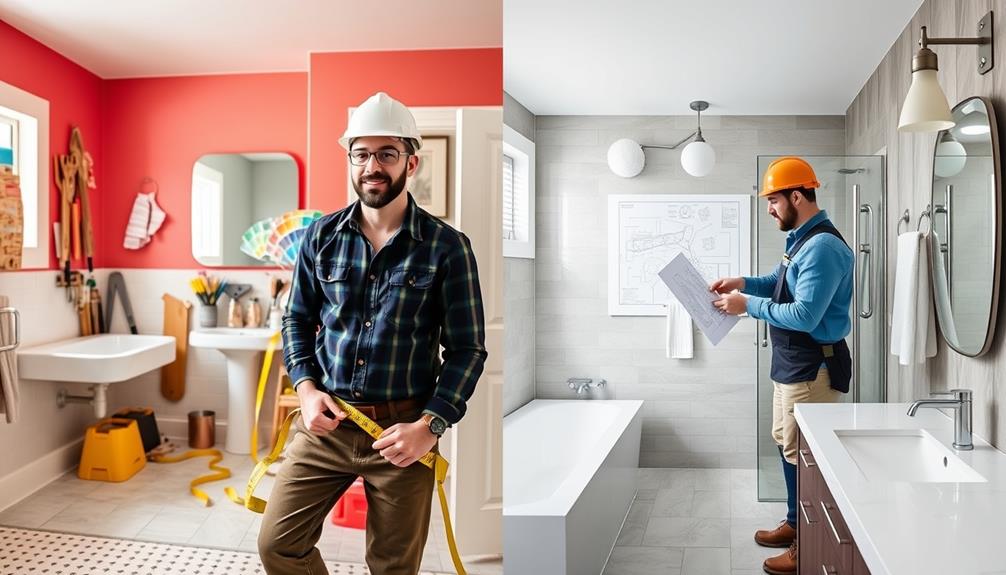
Choosing between DIY and professional help can greatly influence your bathroom remodel budget and timeline. DIY projects can save you 20-30% on labor costs, but they might also lead to longer completion times and mistakes if your skills aren't up to par.
Engaging in a DIY project can also enhance your creativity and give you a sense of personal satisfaction, akin to the transformative possibilities found through the power of imagination. On the other hand, professional remodeling typically incurs higher expenses, as labor costs make up 60-70% of the overall project expenses, but you'll benefit from faster completion and quality assurance.
Here are some points to take into account when deciding:
- Simple DIY Tasks: You can tackle tasks like painting or installing fixtures to save money.
- Complex Work: For complex plumbing or electrical work, hiring a general contractor is essential to guarantee compliance with building codes.
- Acting as Your Own Contractor: Purchasing materials independently can help reduce costs considerably.
- Personal Satisfaction vs. Expertise: DIY offers a sense of accomplishment, while professionals prevent costly errors and provide valuable expertise.
Ultimately, weigh your skills and the complexity of the project to make the best choice for your bathroom remodel.
Finalizing Your Budget Plan
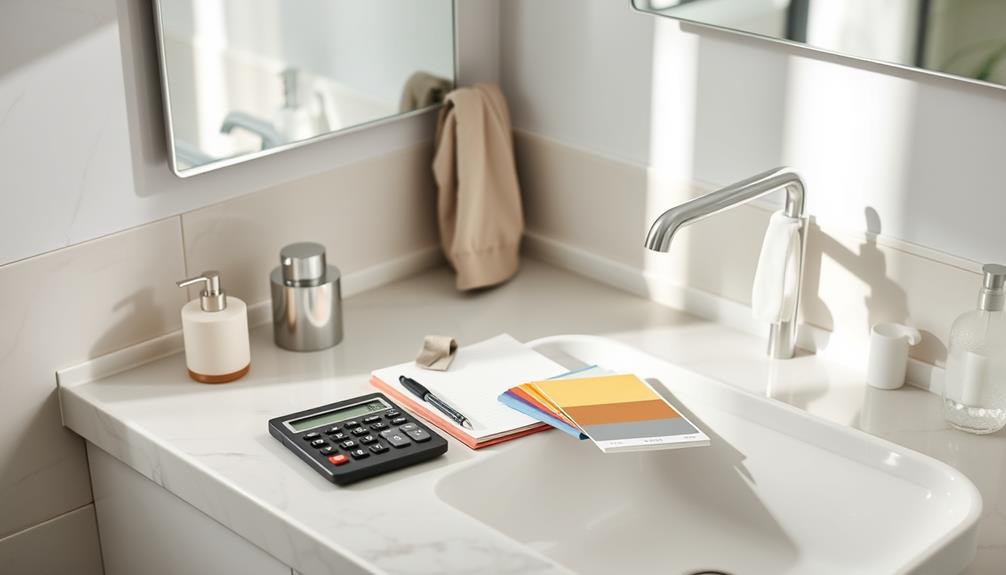
Finalizing your budget plan is essential to guarantee your bathroom remodel stays on track and within financial limits. Start by allocating at least 20% of your total budget for unexpected expenses. Bathroom remodels often reveal hidden issues, like mold or plumbing problems, that can add to your costs.
Next, factor in labor costs, which typically range from 60% to 70% of your budget. Electricians usually charge $65-$85/hour, while plumbers charge around $45-$65/hour.
Establish a clear scope of work and set realistic goals to obtain accurate estimates and avoid overspending. Decide whether you're aiming for simple fixture replacements or complete gut renovations.
Research material costs thoroughly, as buying materials independently can often save you money compared to purchasing through contractors, who may charge commissions on those materials.
Lastly, be aware that average bathroom remodel costs can vary considerably. Mid-range projects typically average around $20,000. Understanding your specific needs and local market rates is essential for effective budgeting.
Frequently Asked Questions
How Much Should You Spend on a Bathroom Remodel?
You should spend between 5-10% of your home's value on a bathroom remodel. Consider your needs and desired upgrades, while also setting aside at least 20% for unexpected expenses during the renovation process.
What Is the Most Expensive Part of a Bathroom Remodel?
Labor costs often account for 60% to 70% of your bathroom remodel budget. When planning, remember that layout changes can greatly increase expenses due to extensive plumbing and electrical work required for adjustments.
How to Set a Budget for a Bathroom Remodel?
To set your budget, start by defining your project's scope. Research costs, factor in unexpected expenses, and communicate with contractors. Prioritize features and materials to guarantee your budget aligns with your vision and needs.
Can You Redo a Bathroom for ?
Imagine sprucing up a tired garden for $5,000. Yes, you can redo a bathroom with that budget! Focus on cosmetic updates, DIY tasks, and smart material choices to transform your space without breaking the bank.
Conclusion
Now that you've mapped out your budget, consider how your dream bathroom will transform your daily routine. With careful planning and a clear understanding of costs, you can create a space that reflects your style and meets your needs. Are you ready to step into a beautifully remodeled bathroom that feels like a personal retreat? By sticking to your budget and making informed choices, you'll turn that dream into reality without breaking the bank.
